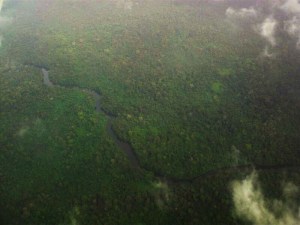This is my first post on a new blog to document some of my activities here in Suriname. I am here working as a curator and researcher in the national entomological collection. I try to get out as often as I can into the field, but it is often very difficult arranging transportation and logistics. About 90% of the entire country is pretty much completely undeveloped, so vast areas of pristine Amazonian rainforest and savanna make up most of the country; only along the coast and immediately inland is there significant urbanisation. Most of the forest in the centre and south of the country is only accessible by light aircraft (normally Cessna 206 or Cessna Caravan) or by canoe. For example to reach Raleighvallen in the central Suriname Nature Reserve, you either take a short flight of about an hour, or you take an 8 hour powered canoe ride up the Coppename river (after an hour’s drive to reach the river from Paramaribo!). Travelling to remote areas is expensive, much, much more so than travelling the equivalent distances in Europe, so all in all, it is sometimes rather frustrating knowing that I am surrounded by all this vast wilderness, but that for much of the time, I am not able to be out there collecting. Nevertheless I have managed to be out in the field for a total of about 1 month out of 3, so I think I am doing quite well!
The forest areas accessible by road from Paramaribo are, as far as I can see, mostly ‘secondary forest’, that is, they have received considerable human disturbance in the past. I can tell this straight away just by looking at a sample of scarab beetles collected from these forests. Whilst still being diverse, they lack certain species that I have come to use as indicator taxa for primary forest. These species are only found in the more isolated forest areas that have not been logged or disturbed. Interestingly, whether these forest areas are used for hunting or not by local people, does not seem to affect the scarab diversity as much as one would have thought, although I need more data and number crunching to completely convince myself!
The second most imprtant habitat in Suriname are the so-called ‘savannas’ and associated savanna-forests. As one would expect, the savannas are areas of open habitat, lacking significant tree cover, whose vegetation is dominated by grasses and various low shrubs and other plants. Usually they occur on very sandy soil, and appear to be ‘dry’ habitats because moisture evaporates much faster in the open, although they receive plenty of rain for much of the year. Within the savanna, there are many small to quite large enclaves of savanna-forest. These are basically little ‘islands’ of dense rainforest on sandy soil. In fact the white sand is what I look for to check that I am in an area of savanna-forest, as opposed to ‘proper’ Amazonian rain forest., Actually I have so far seen little difference in the faunas of savanna-forests and fully developed Amazonian hylea.
The other main habitat found in Suriname are the coastal swamps and mangroves, although I have so far not explored these areas intensively. They are however internationally renowned for their bird fauna because the Surinamese coastline is covered with the rich soil deposits that spew out of the Amazon river and are forced northwards by the prevailing Atlantic currents. As a result, Suriname has very few sand beaches, the coast is mostly mud and the waters are murky and thick with the mineral deposits from the Amazon! Not so great for humans, but fantastic for the bird (and other) life! To the south of the Amazon, the seas are clear, and thus French Guyana has many more beaches than Suriname. By the time you get into Brazil, the coastline is made up of long stretches of beautiful sandy beaches, which are obviously much more popular with humans!

Over the Amazon rainforest in southern Suriname